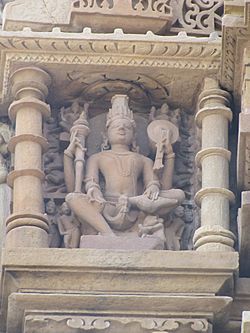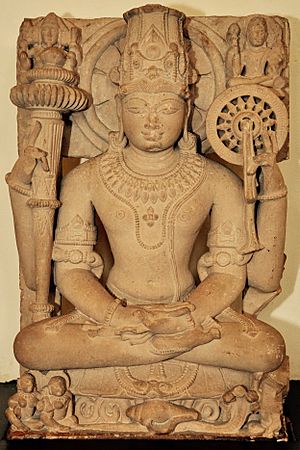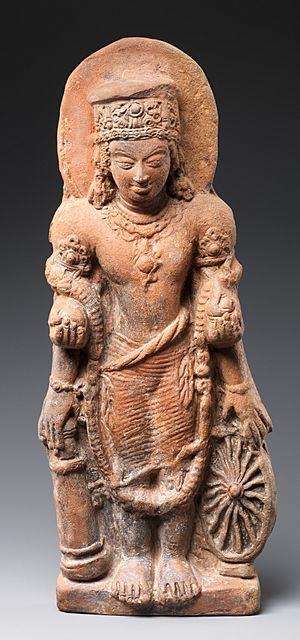Kaumodaki facts for kids
Quick facts for kids Kaumodaki |
|
|---|---|

Vishnu bearing his gada in his right hand, Khajuraho sculpture
|
|
| Devanagari | कौमोदकी |
| Affiliation | Vaishnavism |
| Texts | Mahabharata |
Kaumodaki is the special mace (a type of club weapon) of the Hindu deity Vishnu. Vishnu is often shown holding Kaumodaki in one of his four hands. His other important items are the chakra (a spinning disc), the conch shell, and the lotus flower. This mace also appears in pictures of some of Vishnu's avatars (different forms he takes).
The name 'Kaumodaki' first appears in the ancient Hindu epic Mahabharata. Here, it is linked to Vishnu's avatar, Krishna. The mace has been shown in images of Vishnu since about 200 BCE. At first, it looked very plain. Over time, its size and shape changed in pictures. Later designs included more detailed features like flutes (grooves) and segments.
Sometimes, Kaumodaki is shown as a real weapon. But other times, it appears as a woman called Gadadevi or Gadanari in sculptures of Vishnu. In these pictures, Vishnu might rest a hand on her head. She might be holding the mace herself, or even seem to be coming out of it. Sometimes, the mace is carved on her head or crown.
The mace is seen as one of the oldest and strongest weapons. It represents Vishnu's great power, known as shakti. Many ancient texts talk about what Kaumodaki means in Vishnu's images.
Contents
What's in a Name? The Etymology of Kaumodaki
The exact meaning of the name 'Kaumodaki' is not fully clear. One popular idea is that it comes from the Sanskrit word kumuda. This word means the blue water-lily or blue lotus flower.
Another idea is that the mace's name might come from one of Vishnu's titles, Kumodaka. Or it could be the other way around! The word kaumudi, which is similar to Kaumodaki, means "joy on the earth." Some ancient texts, like the Vishnu Purana, suggest Kaumodaki means "something that amazes the mind."
How Kaumodaki Looks: Iconography
Vishnu is usually shown with four arms. Each hand holds one of his special items: the Panchajanya (conch), the Sudarshana Chakra (disc), the Padma (lotus), and the Kaumodaki (mace). A common name for Vishnu is Shankha-chakra-gada-pani. This means "he who holds the conch, disc, and mace in his hands."
Today, the mace is usually held in Vishnu's lower left hand. The mace also appears in pictures of Vishnu's avatars like Matsya (fish), Kurma (turtle), Varaha (boar), and Narasimha (half-lion, half-man).
The mace first appeared in the oldest known sculpture of Vishnu, from around 200 BCE. In early images from the Kushan Empire (30–375 CE), the mace was simple. It looked like a "round, top-heavy rod" held in his upper right hand. Later, it became a long rod, almost as tall as Vishnu himself. It looked similar to a long pestle (a tool for grinding). Over time, the mace started to be shown in different hands. There are 24 different ways Vishnu's four items can be arranged in his hands.
The design of the mace also changed over time. In later medieval art, especially from the Pala Empire (8th–12th century CE), the handle became smaller. The top part became very decorated and round. In some regions, the mace was thick and barrel-shaped. In others, it was thinner but had ridges and segments.
Kaumodaki as a Person: Gadadevi
Ancient texts describe how Vishnu's items can be shown as people. The Vishnudharmottara Purana says that the mace can be a slim-waisted woman. She holds a Fly-whisk (a ceremonial fan) and wears ornaments. Vishnu's right hand rests on her head. This personified mace is known as Gada-Devi (meaning "mace goddess") or Gada-nari ("mace woman"). Since the Sanskrit word gada is feminine, the mace is seen as a woman.
These personified weapons, called Ayudhapurusha, started appearing in sculptures from the Gupta Empire (320–550 CE). Gadadevi often appears in Vishnu images from Kashmir. This includes Vishnu's four-headed form, Vaikuntha Chaturmurti. She holds a chamara (fly-whisk) and looks lovingly at Vishnu. She wears a crown or has a fancy hairstyle. She is sometimes shown coming out of the mace itself.
Gadadevi can be shown as a small figure or as a normal human. Sometimes, she is shown holding the mace herself. In other cases, she stands next to Vishnu with her hands folded in prayer. The mace might be shown on her head as part of her crown, or as a mark on her forehead.
Meaning and Importance of Kaumodaki
The mace or club is one of the oldest types of weapons. It was a common weapon for fighting close up and was seen as the strongest. Its popularity might be why it is shown with Vishnu. Vishnu's items often come from his avatars, like Rama and Krishna. These heroes are from the ancient Hindu epics, Ramayana and Mahabharata. Both epics describe gods, humans, and demons using the mace.
In the religious teachings of the Vaishnava group, Kaumodaki has a deeper meaning. It represents "intellect," "the power of knowledge," and "the power of time." The Gopala Tapani Upanishad says the mace represents ancient knowledge. It is held in the lower left hand, which stands for "individual existence." The Vishnu Purana also says the mace is the power of knowledge. Kaumodaki is said to "intoxicate" or amaze the mind.
According to the Vishnudharmottara Purana, Kaumodaki represents Vishnu's wife, Lakshmi. Lakshmi is the goddess of wealth and beauty. The Krishna Upanishad compares the mace to the goddess Kali, who is "the power of time." This text says that like unstoppable Time, the mace destroys all enemies.
Another idea is that Kaumodaki represents the life-force (prana). This is the energy from which all "physical and mental powers" come. Vishnu's mace also stands for discipline. His lotus, on the other hand, means praise. While the lotus and conch are water symbols representing life and love, the mace and disc are fire symbols. They represent pain and destruction. They also remind us to follow the rules of society and nature. The Varaha Purana says the mace is used to teach lessons to rulers who are not religious. Vishnu is also said to clear away illusion with his mace.
Kaumodaki in Stories: Literature
In the Mahabharata, Kaumodaki is described as sounding like lightning. It was powerful enough to defeat many daityas (demons). The god of the seas, Varuna, gave it to Vishnu-Krishna.
There's a story where the fire-god Agni wanted to burn down the Khandava Forest. He asked the Pandava prince Arjuna and his friend Krishna for help. Agni was worried that Indra, the king of the gods and protector of the forest, would stop him. Arjuna and Krishna agreed to help. Varuna gave them special weapons. Krishna received the Sudarshana Chakra and the Kaumodaki mace. Arjuna got the bow Gandiva and divine arrows. With these weapons, they defeated Indra, and Agni burned the forest. This allowed the Pandavas to build their capital city, Indraprastha.
The Mahabharata also mentions Vishnu holding a mace and a disc. This might mean that some early images of Vishnu showed him with only two arms. The Mahabharata also tells how Krishna's Kaumodaki and other weapons appeared as humans from the heavens to watch a battle. The Harivamsa, another ancient text, says four of Vishnu's weapons fell from the heavens to help Krishna and his brother Balarama in a battle. Krishna fought with Kaumodaki and the bow Sharanga.
The play Duta-Vakya by the ancient writer Bhāsa describes a scene from the Mahabharata. Krishna shows his Vishvarupa (his all-powerful "Universal form") in the court of Hastinapur. He calls his weapons, and they appear as humans, including Kaumodaki.
The Garuda Purana also mentions Kaumodaki in a prayer to Vishnu:
Take up thy club Kaumodaki, O lotus-navelled deity, salutation unto thee.




